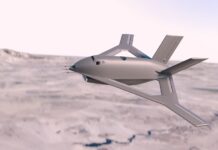One of the major displays by Lockheed Martin was an operational prototype of the U.S. Army’s new Enhanced AN/TPQ-36 radar, known as the EQ-36 Counterfire Target Acquisition Radar. In January 2007 Lockheed Martin was selected as prime contractor of on this program.
EQ-36 will be able to detect, classify, track and determine the location of enemy indirect fire such as mortars, artillery and rockets in either 90 degree or 360 degree modes. The 360 degree mode is of special advantage for force protection in a modern, asymmetric warfare. Such performance poses more challenging task for current artillery location radars, covering a limited 90 degrees sector.
The new radar will replace aging TPQ-36 and TPQ-37, currently in service, with a compact, mobile and more agile system. The current prototype is based on a technology demonstration system developed by one of its team members, Syracuse Research Corp. (SRC) for Army’s Intelligence & Information Warfare Directorate (I2WD) in Ft. Monmouth, NJ.
In 2007 the prototype successfully completed air surveillance and counterfire target acquisition testing in both 90- and 360-degree modes. “We are on the fast track with this program. While radar design and production of an engineering design model typically takes 48 months, we already have a field-tested, operational prototype for EQ-36 after only nine months” said Carl Bannar, vice president and general manager of Lockheed Martin’s Radar Systems business.
The EQ-36 program has been under way since January 2007, following Lockheed Martin’s contract award of approximately $120 million by the Army’s Program Executive Officer-Intelligence, Electronic Warfare & Sensors (PEO- IEW&S). The company will provide the Army with five Enhanced AN/TPQ-36 radars within 36 months. The first two systems will be delivered to the Army by summer 2009; the third and fourth by fall 2009, and the fifth by early 2010.
Lockheed Martin’s Radar Systems facility in Syracuse, NY leads the industry team for the EQ-36 program and is also responsible for the transmit/receive (T/R) modules, the antenna array and the digital module assemblies. Syracuse Research Corp., also of Syracuse, NY, is responsible for the digital signal processor; while Lockheed Martin Simulation, Training & Support, of Orlando, FL, will lead the development and production of the EQ-36 training system and curriculum. Tobyhanna Army Depot, of Tobyhanna, PA, is charged with sustainment maintenance support. The operations shelter and stationary platforms will be provided by Burtek, Inc., of Chesterfield, MI.












